Naebang-gasa
Type
Hwajeonga-ryu (花煎歌類)
It is one of Gasa-ryu (type) in which women who are tired of relationships with in-laws are on an outing in spring and enjoy Hwajeon (flower pancake) Nori. It shows their feelings of being released and free from their daily lives even for a moment.
Daphwasuga
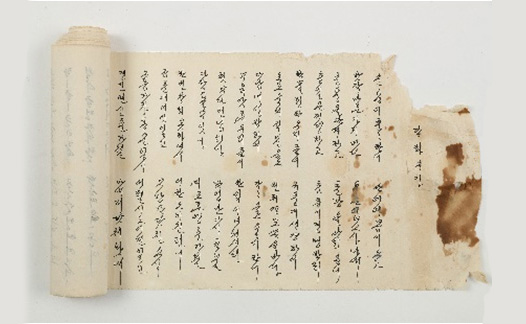 Daphwasuga / 1980 / 24.2×412.1㎝
This is a response to “Hwaryuga” by “Oenaedaek” from the third month in the year of Gyeongsin. It is written in the eighth month of the same year. At the end, it is concluded as “Oenae Hyeongimge Butchim (To the older sister in law of Oenae)” and shown as it was written by “Sadondaekdongseo (the younger sister in law).” It is clear that women did continue to talk to each other after Hwajeonnori.
Daphwasuga / 1980 / 24.2×412.1㎝
This is a response to “Hwaryuga” by “Oenaedaek” from the third month in the year of Gyeongsin. It is written in the eighth month of the same year. At the end, it is concluded as “Oenae Hyeongimge Butchim (To the older sister in law of Oenae)” and shown as it was written by “Sadondaekdongseo (the younger sister in law).” It is clear that women did continue to talk to each other after Hwajeonnori.
Syeokchyunga
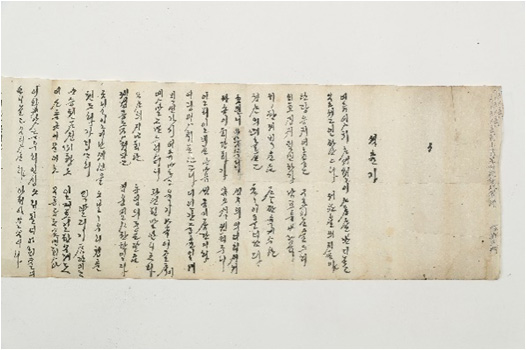 Syeokchyunga / Early 1900’s / 22.9×210.4㎝
It is the transcribed copy of Seokjunga (惜春歌), which is about that women go on outings to mountain fields, and rivers in search of flowers, write lyrics, and sing the scenery of spring in March. At the beginning of the scroll, the record about the transcriber is indicated as “Yeogju-gun Pyeongeun-myeon Sudo-ri Gojongmaessi Piljeok Gajeongssimun (榮州郡 平恩面 水島里 姑從妹氏 筆跡 嫁鄭氏門).”
Syeokchyunga / Early 1900’s / 22.9×210.4㎝
It is the transcribed copy of Seokjunga (惜春歌), which is about that women go on outings to mountain fields, and rivers in search of flowers, write lyrics, and sing the scenery of spring in March. At the beginning of the scroll, the record about the transcriber is indicated as “Yeogju-gun Pyeongeun-myeon Sudo-ri Gojongmaessi Piljeok Gajeongssimun (榮州郡 平恩面 水島里 姑從妹氏 筆跡 嫁鄭氏門).”
Imdanghoeryuga
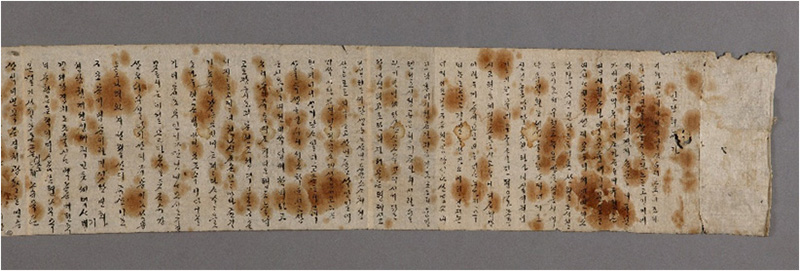 Imdanghoeryuga / 1968 (The year of Musin) / 29.5×330.0㎝
The woman living in Imdang sings about the scenery and her feelings from it from Hwajeonnori. “Hoeryuga” seems to be the misspelled version of “Hwaryuga.”
Imdanghoeryuga / 1968 (The year of Musin) / 29.5×330.0㎝
The woman living in Imdang sings about the scenery and her feelings from it from Hwajeonnori. “Hoeryuga” seems to be the misspelled version of “Hwaryuga.”
Chunyurok
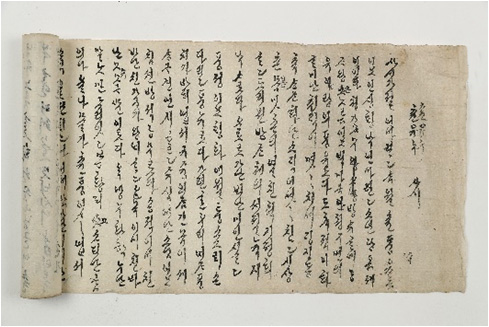 Chunyurok / Early 1900’s / 25.2×223.6㎝
“Chunyurok (春遊錄)” is about the writer’s feelings from Hwajeonnori for which women suffering from relationships with in-laws prepare food and go on an outing together for the flower pancakes. At the end, she says to be born as men in next lives and enjoy.
Chunyurok / Early 1900’s / 25.2×223.6㎝
“Chunyurok (春遊錄)” is about the writer’s feelings from Hwajeonnori for which women suffering from relationships with in-laws prepare food and go on an outing together for the flower pancakes. At the end, she says to be born as men in next lives and enjoy.
Hwaryuga
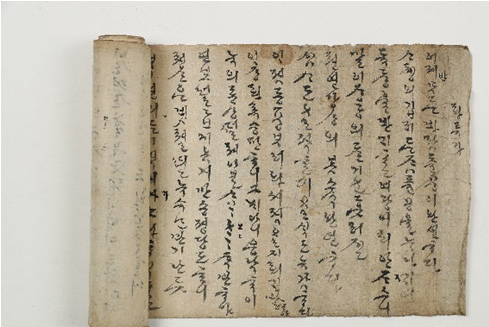 Hwaryuga / 1930 (The year of Gyeongo) / 25.5×508.5㎝
After singing about the spring with flower blossoms and birds singing, the writer goes up to Buyongdae and sings about the scenery of Hahoe Village. In the piece, the font size changes and there are some traces of corrections in the middle. The transcription ate is indicated at the end of the piece.
Hwaryuga / 1930 (The year of Gyeongo) / 25.5×508.5㎝
After singing about the spring with flower blossoms and birds singing, the writer goes up to Buyongdae and sings about the scenery of Hahoe Village. In the piece, the font size changes and there are some traces of corrections in the middle. The transcription ate is indicated at the end of the piece.
Hwaryuga
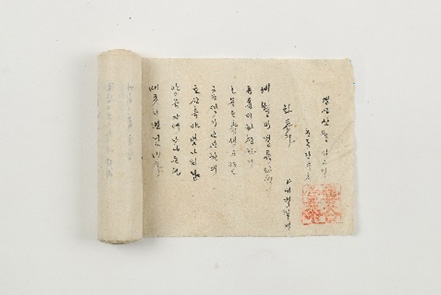 Hwaryuga / 1980 / 16.0×461.5㎝
The piece is about going to Hwajeonnori to celebrate spring and the writer’s feelings about it. It is transcribed on both sides of a scroll. A specific name of region is not revealed, and the contents is about how the writer is impressed with the scenery. Prior to the title, other information is recorded including the owner, the transcription date of “the 19th day of the third month in the year of Gyeongsin,” and the transcriber of “Oenaedaek.”
Hwaryuga / 1980 / 16.0×461.5㎝
The piece is about going to Hwajeonnori to celebrate spring and the writer’s feelings about it. It is transcribed on both sides of a scroll. A specific name of region is not revealed, and the contents is about how the writer is impressed with the scenery. Prior to the title, other information is recorded including the owner, the transcription date of “the 19th day of the third month in the year of Gyeongsin,” and the transcriber of “Oenaedaek.”
Hwasyuga
 Hwasyuga / Late1800's / 22.5×31.5㎝
The women are playing with flower pancakes (Hwajeon) in spring, relieving stresses from relationships with their in-laws and enjoying the mood of the season. Long strokes at the ends of the font used are impressive.
Hwasyuga / Late1800's / 22.5×31.5㎝
The women are playing with flower pancakes (Hwajeon) in spring, relieving stresses from relationships with their in-laws and enjoying the mood of the season. Long strokes at the ends of the font used are impressive.
Hwajyeonga
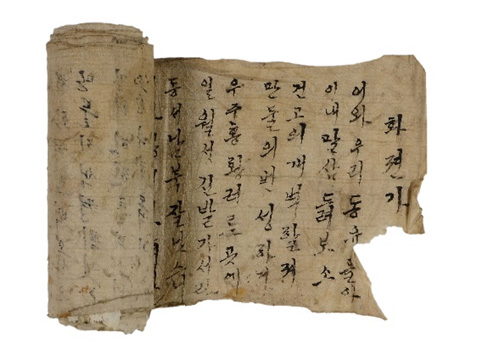 Hwajyeonga / Early 20th century / 11.8×616.0㎝
The lyrics are about going out on Hwajeon Nori in spring. No specific name of the area is revealed. At the end, the time and place of the transcription are mentioned as “in Odae (梧垈), Imha-myeon (臨河面), during the first month of the year of Gapo.”
Hwajyeonga / Early 20th century / 11.8×616.0㎝
The lyrics are about going out on Hwajeon Nori in spring. No specific name of the area is revealed. At the end, the time and place of the transcription are mentioned as “in Odae (梧垈), Imha-myeon (臨河面), during the first month of the year of Gapo.”
Hwajyeonga
 Hwajyeonga / Early 20th century / 22.5×207.0㎝
It is Hwajeonga written in March 17, the year of Inja, during Samchun (三春, three months of spring) by the wife of Kim In-gu, Musil Daejongnyeo Hujodang of the Gwangsan Kim family. It is about feelings and moods from Hwajeon (flower pancake) Nori she went on in spring.
Hwajyeonga / Early 20th century / 22.5×207.0㎝
It is Hwajeonga written in March 17, the year of Inja, during Samchun (三春, three months of spring) by the wife of Kim In-gu, Musil Daejongnyeo Hujodang of the Gwangsan Kim family. It is about feelings and moods from Hwajeon (flower pancake) Nori she went on in spring.
Hwajyeondapga
 Hwajyeondapga / Early 20th century / 22.7×207.0㎝
It is included in Hwajeondapga wordbook. On the seventeenth day of March, in the year of Imja, Mangyeongdang, the third daughter of Jusa Kim from the Andong Kim family wrote it. It expresses feelings from Hwajeon Nori at Agisan Mountain in Sugok, Andong, and praises the scenery and accomplishments of the Jeonju Ryu's Jipseongchon Village.
Hwajyeondapga / Early 20th century / 22.7×207.0㎝
It is included in Hwajeondapga wordbook. On the seventeenth day of March, in the year of Imja, Mangyeongdang, the third daughter of Jusa Kim from the Andong Kim family wrote it. It expresses feelings from Hwajeon Nori at Agisan Mountain in Sugok, Andong, and praises the scenery and accomplishments of the Jeonju Ryu's Jipseongchon Village.
Hwajyoga
 Hwajyoga / Mid 1900’s / 16.8×239.8㎝
Under the Korean title is the Chinese character title of “Hwajoga (花調歌).” As “Hwajo” is used to have the same meaning as “Hwajeon (花煎, flower pancake),” it is expressed as “Hwajyonori” in the piece. It is about going to Hwajeonnori to celebrate spring and the writer’s feelings about it. At the end, it advises, “It is transcribed by Kim Damhyodaek. Don’t show it to others as there are many scribbles.”
Hwajyoga / Mid 1900’s / 16.8×239.8㎝
Under the Korean title is the Chinese character title of “Hwajoga (花調歌).” As “Hwajo” is used to have the same meaning as “Hwajeon (花煎, flower pancake),” it is expressed as “Hwajyonori” in the piece. It is about going to Hwajeonnori to celebrate spring and the writer’s feelings about it. At the end, it advises, “It is transcribed by Kim Damhyodaek. Don’t show it to others as there are many scribbles.”













